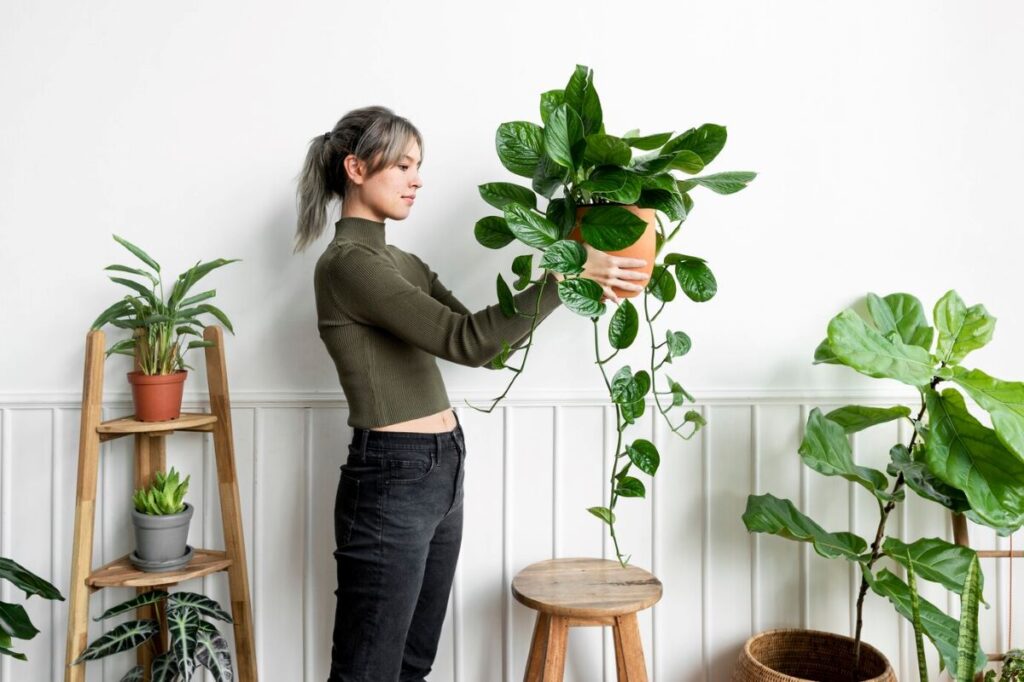Due to their spectacular looks, as well as many qualities such as purifying the air and boosting oxygen levels, here’s our list of the top 5 indoor houseplants and how to care for them.
- Chrysanthemums (Chrysanthemum morifolium)
Chrysanthemums are also known as hardy garden mum or florist’s daisy. This aesthetically pleasing plant from the Asteraceae perennial plant family typically grows to about 2-3 inches tall.
Care Instructions
- Using plant feed, you must on a regular basis fertilize your Chrysanthemums to get the best look from it.
- During its growing season as well as when it starts to bloom, keep its soil moist by watering it regularly.
- It’s best planted in an organic-rich soil that’s slightly acidic.
- String of Hearts
This gorgeous looking plant also known by the following names – rosary vine, Chinese lantern, chain of hearts, as well as its botanical Ceropegia woodii is believed to be one of the most tolerant houseplants to have in any living space.
Care Instructions
- Light is crucial to the growth and flower production of String of Hearts. So, it’s best to place the plant where it’ll have contact with bright filtered sunlight.
- For its best soil condition, a potting mix that is well-drained is its best bet for an even fertilization. Regularly feed your String of Hearts with fertilizers low in nitrogen and specifically designed for succulents’ plants.
- This drought-tolerant plant still prefers regular deep watering to thrive. However, it’s best to have good drainage pots to prevent them from standing in water which can have adverse effects on them such as their leaves dropping, swollen drainage or even death.
- Snake Plants
Snake Plant is one of the most effective oxygen producing plants. By converting carbon dioxide into oxygen at night, Snake Plants help to filter and regulate healthy indoor airflow. Snake Plants are also known by the names “Mother-in-Law’s Tongue,” and Sansevieria.
Care Instructions
- Snake Plants placed in spaces that have low light are required to be repotted every 5 to 10 years, and 3 to 6 years for those near bright lights. However, many gardeners would rather prefer that the plants break their pots by multiplying before they repot. Caution is advised when repotting as to not to bury them too deep. Terra cotta pots are highly recommended for potting Snake Plants.
- It’s best to wait for your Snake Plant’s soil to dry out before rewatering, this helps prevent it from developing rotting roots common with overwatering. It is recommended that when watering you start from the root up, this encourages deep growth which helps to maintain its tall and thick leaves.
- Because its leaves are flat and large, collection of dust often occurs. Wiping them with a damp cloth helps to keep them clean. During the winter, while the plant isn’t actively growing, water less often than you would in spring and summer.
- Peace Lily
Peace Lilies are touted as one of the best plants to give as a gift. Firstly, stemming from its name, and secondly because of its ease of growth and maintenance. Not only does this plant brighten up spaces, but it also helps purify the air at the same time. Peace Lily blooms its poinsettia-like modified leaf around springtime, although some very healthy ones may bloom again in fall.
Care Instructions
- Avoid placing Peace Lilies near spaces it’ll have direct contact with cold air as they thrive in warmer temperatures.
- Feed your Peace Lily plant with organic fertilizers only. Avoid chemical fertilizers as they are extremely sensitive to them.
- Water your Peace Lily a lot at once, then leave it to completely dry out before rewatering. The best time to rewater is when it starts to droop, usually a day before. To keep it hydrated during summer, it’s best to water it once weekly and then spritz its leaves with water throughout. The plant should be kept moist but never soggy.
- Philodendron
Philodendrons have many varieties, with its most common being the climbing type. These plants are very easy to grow and maintain. They have heart-shaped leaves and are deep green in colour. For best quality, Philodendrons are best positioned near indirect light, preferably near a window. You will know it’s getting too much light when its leaves turn light green.
Care Instructions
- Do not allow Philodendron to stay wet for too long. It’s best to pot them in a well-drained container for even moist exposure.
- Feed them doses of fertilizer regularly monthly, especially during its most active growth stage during the spring and summer months.
- Philodendron should be repotted with fresh soil every two years. This plant is known to develop leaf burn (a situation where its leaf tips turn yellow and brown) from accumulated salt deposits from water. This can be prevented by running water through the soil until the bottom of the pots produces clear water to thoroughly flush it.
Chinenye Emezie | Assistant Editor










